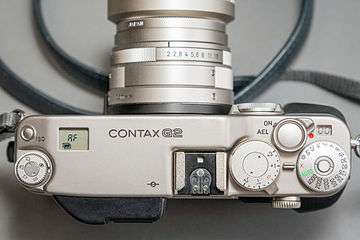Contax G
 | |
| Type | 35 mm rangefinder camera |
|---|---|
| Lens mount | Contax G-mount |
| Focus | AF |
| Exposure | auto |
| Flash | hot shoe |
The Contax G1 and Contax G2 are interchangeable-lens cameras sold by Kyocera under the Contax brand in competition with the Leica M7, Cosina Voigtländer Bessa-R, and Konica Hexar RF. The G1 was introduced in 1994 with the G2 joining it in 1996. In 2005, Kyocera announced it would cease all activity related to the manufacture of Contax cameras at the end of the year, effectively spelling the end of the G system.
The titanium-bodied G-series cameras do not use the traditional Leica M-mount seen on many rangefinder cameras, but the Contax G-mount, an electronic autofocus mount. Critics were quick to accuse the camera of not being a "true" (mechanical) rangefinder, since it used autofocus and electronically linked mechanisms. But the AF mechanism in the G-series does indeed use a twin-window system much like that of the older mechanical rangefinders — only in electronic form. While there is electronic connection between camera and lens, lenses have no AF motor and autofocus is performed via "screw drive" motor in camera.

The lenses designed by Carl Zeiss for the G-series quickly established it as a camera of worth: the original 45 mm f/2 Planar was joined by a 28 mm f/2.8 Biogon and a 90 mm f/2.8 Sonnar; a 21 mm f/2.8 Biogon, 16 mm f/8 Hologon, 35 mm f/2 Planar and 35–70 mm f/3.5–5.6 Vario-Sonnar were added later. The 45 mm Zeiss Planar in particular gained renown as the second-sharpest 35 mm camera lens ever tested by the Swedish test site Photodo[1] — outclassing the Leica 50 mm Summicron-M.
The very high optical quality of the G-series lenses makes them excellent candidates for use with high-resolution digital sensors. Adapters are available for the Sony E-mount and Micro Four Thirds digital cameras. Adapter produced by TechArt Pro for Sony E cameras has autofocus motor and provides autofocus as well as EXIF support; however, reliable autofocus only works on later camera bodies which support PDAF for legacy lenses.
Early versions of the G1 could only accept the 28 mm, 45 mm and 90 mm lenses. Later versions, referred to as "green label" with a green sticker inside the film door, could accept the 21 mm and 35 mm lenses. No G1 could accept the 35–70 mm, as it was a seven contact electrical connection and the G1 only features five contacts. The 16 mm would attach and function, however, the viewfinder could not adjust for it so an external viewfinder that plugged into the hotshoe was required.
Compared with the original G1, the G2 has improved autofocus performance and higher top shutter speeds of 1/4000 sec in manual mode and 1/6000 sec in aperture priority mode. The manual focus wheel was moved from the top deck to the front, to about the same position as where the focusing wheel was located on classic Dresden and Stuttgart Contax rangefinders. The G2 auto-focus also has two focusing modes: continuous, which constantly adjusts focus as the camera is moved; and single, which is a safety mode, focussing as the focus button is pressed (or shutter release half-pressed), and maintaining this reading until the shutter is released. If the camera fails to find focus in this mode, the shutter cannot be released.
 Contax G1 rangefinder |
 Contax G2 rangefinder |
 Contax G1 top |
 Contax G2 top |
References
External links
| Wikimedia Commons has media related to Contax G. |